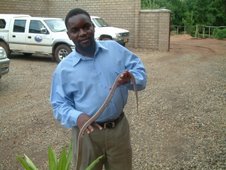this article appeared in the Nation Newspeper on Thursday 16th August, 2007
MOUNT MULANJE
By Hastings Maloya
Historically it is recorded that Mulanje Mountain and its forest reserve was once home to the first Malawian settlers. Recorded history indicates that the inhabitants in the mountains were dwarf people locally known as Amwandionerapati or Abathwa. It is said that they were a people with diminutive height who lived on hunting. The name Abathwa purely meant short people. However, it is said that the said people never liked being called or referred to as being short.
Fifty-eight year old Sankhulani Musopa who lives close to the mountain says there had been people that had an opportunity to see the early settlers in the reserve. He says each time one met them, they would, in quite a war-like manner, ask; “from where did you see us?” To that question, they expected the respondent to say that he/she had seem them from very far. They could then feel very proud. They were not too short to be noticed from far, anyway! They were speaking chinyanja and their question was coming like “mwandionera pati? Hence they were called Amwandionerapati.
Musopa says there had also been cases that they could provide well-cooked food, fruits and some presents if you were lucky to meet them.
“You could find well prepared food on your way, all you needed to do was eat and make no noise about it,” says Musopa but fails to link the preparation of such food and other stories about spirits in the mountain. Very little is known as to how these early settlers disappeared from the mountain’s forest reserve. Or are they still there?
Ever since the stories of the early settlers lessened, Mulanje Mountain has, over the years, mostly and moderately just known as the largest mountain in Central Africa. Of course its beauty has been written in different periodicals and recorded in different media. And tourists from all over the world have been to Mulanje Mountain. But until September 2003, it was known otherwise, it became a mountain in which people can go missing and never be found.
Yes the story of Linda Pronk was a turn of stories associated with Mulanje Mountain. Linda, a 22-year-old Dutch citizen, who one fateful Saturday in 2003, tried to set off, alone, to climb Sapitwa peak, and she has not been seen since. Sophisticated search methods were applied, traditional healers and medicine people came with different skills and approaches, preachers and leaders of different religions and beliefs also participated in the search. All efforts were done to search for Linda, hopes were raised but still it is four years now and no success registered.
As for the local people living around the mountain, ancestral spirits played a role in the missing of Linda. They say there are spirits in the Mulanje Mountain Forest Reserve and can react in case they are not happy with a particular situation. One does not need to be forced to believe that neither is one expected to dispute such beliefs.
“My advice is that we should visit the mountain with respect. This is a treasurer for the people of Mulanje and Phalombe. It must be respected,” says a chief from Phalombe without elaborating. To date, there is nothing conclusive as to what exactly happened. Someone is yet to come up with a possible assumption.
Musopa says, “Sometimes you can not tell about this mountain. Some things that happen here, you just can not understand them, maybe thus what makes this mountain important and unique.”
All in all, this tragic incident on the mountain should serve to remind us all to strongly adhere to the well-established safety principles that guide mountain climbing.
No-one can really tell what exactly happened to Linda. However, notwithstanding this unfortunate event, Mount Mulanje remains one unique resource for Malawi as it continues to attract tourists from all over the world.
Situated about 80 km from the commercial city Blantyre, past the green beautiful tea field of the Thyolo Highlands, the attractive Mulanje with its Sapitwa Peak, standing over 3000m above sea level, is not only the highest mountain but also the most impressive and unique massif in the southern and central African region. With its evergreen forests, woodlands and montane grasslands, the mountain has attracted increasing attention to many tourists.
And now with the newly christened Robert Mugabe Highway, the distance between Blantyre and Mulanje has been reduced by thirty kilometers which makes it easier for a day visit and fun for rock climbers.
Mulanje Mountain is much more than a barren rock. Covering an area of 640,000 hectares within Mulanje and Phalombe districts, the mountain has a Forest Reserve thus made up of a range of ecological habitats from rain forest to alpine, woodland to grassland. There is a great diversity of plant and animal life and many of species are endemic. The most famous endemic is the magnificent and endangered Mulanje cedar, Malawi’s National Tree, which dominates the high altitude forests.
Apart from the famous Sapitwa Peak, there are a lot of striking sites on this massif that has a grouping of lovely hills. Some appealing sites on top of the mountains include the splendid Chambe basin and the superlative Lichenya and wonderful Sombani Plateau. How about the outstanding Ruo Gorge and exquisite water falls? The weather on the top, with the breeze from the natural woodlands, makes the mountain an alternative place worth spending time at.
Up the Likhubula river, is the historical and wonderful Dziwe la Nkhalamba falls with extremely cold waters and a lovely place for picnics. It has one of the breathtaking waterfalls that would entice you to spend a day watching it. How about enjoying a swim! A walk into the mountain and its reserve, makes one appreciate the wonders of nature.
A group of students from England that visited the mountain recently saw the need to leave a comment about the mountain. After what they called 'a three hour task of climbing the hills up to Chambe peak,' the students wrote in a visitor's book: "What seemed to be a never ending uphill trudge soon led us over the hill to our first view of the beautiful Chambe peak." Three days of their stay in a suitable mountain hut was too little for what they were to see on the mountain. They left with emotive words describing what they saw; "Absolutely gorgeous place that will be described to all of England when we get home. Loved it!"
Mulanje Mountain and its forest reserve was gazzeted as a protected area by the then Nyasaland government in 1927 and to date it is Malawi’s oldest forest reserve.
I WELCOME you!
Dear Good People,
I warmly welcome you to my Blog and it is my profound hope that you will find it useful and worth the time you spend on it. On this Blog, I have posted some of the articles and pieces that I have writen just for record purposes and also for sharing. You might have read these articles in the papers but it could also be possible that you missed them.
Please be advised that these are my toughts and purely my opinions. You are free to comment on them and/or to critic them. I will appreciate any of your comments.
Thank You.
Hastings Maloya
+265 888864241 or +265 999950953
I warmly welcome you to my Blog and it is my profound hope that you will find it useful and worth the time you spend on it. On this Blog, I have posted some of the articles and pieces that I have writen just for record purposes and also for sharing. You might have read these articles in the papers but it could also be possible that you missed them.
Please be advised that these are my toughts and purely my opinions. You are free to comment on them and/or to critic them. I will appreciate any of your comments.
Thank You.
Hastings Maloya
+265 888864241 or +265 999950953
About Me
- Hastings A. MALOYA
- Mulanje, Southern Region, Malawi
- Is an experienced journalist, writer, specialist in development communications, public relations, publications, desktop publishing, information technology, photography, environmental education and rural development. Hastings Maloya is currently working as Programme Officer responsible for Environmental Education, Awareness and Communications for the Mulanje Mountain Conservation Trust (MMCT) since September 1, 2002. Hastings, comes from Tradional Authority Mabuka in Mulanje District, is an Adventist Christian, and has two daughters Eva and Eve.
Subscribe to:
Post Comments (Atom)








No comments:
Post a Comment